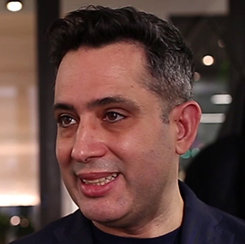Video by Yunuen Bonaparte
Relly Brown was so destitute in 2016 they could not even get a room in the abandoned house on the corner of Fountain Avenue and Cherokee Avenue in Los Angeles. They had to settle for the porch.
Some days Brown, who uses the pronouns they or their, had to steal food. Some days they went hungry. Every day they were filled with despair.
Their companion was a pesky raccoon who wanted to steal the food Brown took. Their bigger fear were the thugs that roamed the streets. “I slept with one eye open,” they said.
They were homeless.
Then, one day, they were not.
As part of the Host Homes program created by Point Source Youth, a resident of Santa Monica, Calif., who wishes to remain anonymous, took Brown into his home, giving Brown a bridge from the street to permanent residence. Brown, now 26, needed a reset to their life, but couldn’t get it in the chaos of the street. They needed a bed, food, comfort to gather themselves.
The host “was the most amazing person I ever met,” Brown said. “I told him everything and he listened. I felt safe, and I felt comfortable at the house, he became like family. I had my own space. I had my own bathroom.”
Brown was able to push reset and is now thriving with a full-time job as a youth counselor, is out of the Host Homes program and has their own apartment.
The program is an example of what works in the fight against youth and young adult homelessness.
Brown is older, but their story of unsettled family life and fleeing turmoil in Washington, D.C., is similar to that of many youth who have had to bunk on the streets.
According to the Coalition for Juvenile Justice, a study of 11 cities found that 44% of youth in those cities who were runaway or homeless had stayed in jail, prison or some juvenile detention facility. A staggering 78% of youth who were runaway or homeless had some interaction with the criminal justice system.

Larry Cohen
Larry Cohen is the executive director and co-founder of Point Source Youth, a national nonprofit dedicated to ending youth homelessness. There should not be a profit motive tied to ending the crisis, he said. Americans have a duty.
“I was talking to a Silicon Valley business person and told them about Host Homes and he made a face and said, ‘What is the financial incentive for the host?’” Cohen said. “That is the kind of thinking that has to change.”
Jonathan Ogden, a consultant on youth homelessness in rural areas for Point Source Youth, said, “It doesn’t cost a cent to care.”
What else works? Data
In 2017, the U.S. Department of Housing and Urban Development (HUD) created the Youth Homeless Demonstration Program. HUD invested $33 million in communities devoted to ending youth homelessness as part of this program. In 2018, HUD put another $43 million into the program.
One initiative spurred by HUD money was the 100-Day Challenge On Youth Homelessness. The methodology for the 100-Day Challenge was created by Rapid Results Institute, which trains local communities around the world in the choreography of a 100-day social initiative.
In one example of the 100-Day Challenge, administered by A Way Home America with RRI methodology, HUD money tackled the issue of a high percentage of youth aging out of foster care being made homeless. A community organization in Cleveland used RRI tactics and found housing for 103 youth and young adults in 100 days in 2018.
In Louisville, Ky., the 100-Day Challenge had a goal of stable housing for 100 youth and young adults ages 16 to 24. The focus was education and ongoing support.
With the challenge, stable housing was found for 115 people, including 23 under the age of 18.
Youth homelessness has become such a complex issue its solutions have to be driven by data and research. Analytics must be brought to bear on the issue.
Youth Collaboratory (YC) is a technical assistance provider for HUD. It works with 200 community organizations by defining the issue then helping to collect, aggregate and translate data into information that can be acted upon. It has also provided research to Chapin Hall, a think tank on social issues at the University of Chicago.
“We have been working [nationally] in silos, and we all have been thinking about what is just in our lane and wondering why we are not having greater success,” said

Josephine Pufpaff
Josephine Pufpaff, director of systems improvement and youth homelessness at Youth Collaboratory. “We are [now] being more data-driven and increasing our capability to plug those holes.”
For example, in research coordinated with Chapin Hall, YC helped develop a
specific risk assessment tool for youth experiencing homelessness — the Next Step Tool. It examines how well risk assessment scores predict service placements and outcomes of young people coming into homelessness systems.
Landmark opinion but only in Boise
This milestone court case not only applied to homeless youth, but also to veterans, families with children, mental health patients and other adults who experience homelessness.
On Sept. 4, 2018, the 9th Circuit Court of Appeals blocked the city of Boise, Idaho’s anti-camping ordinance. The 9th Circuit agreed with plaintiffs in Martin v. Boise that the city violated plaintiffs’ Eighth Amendment Rights when it issued tickets to people sleeping or camping in public.
The court ruling means Boise cannot ticket youth and others for camping out. That one ticket can be the first step — a gateway — to permanent residence in the criminal justice system. A fine is not paid and a fee is tacked on. The police stop the youth for another infraction, see the unpaid fine on their record, and it is off to a detention center. In Boise, that cycle has been interrupted, which is a success story in the fight against youth homelessness.
How foster care could help
What could happen next?
There is no state with an extended foster care program that adjudicates youth after their 18th birthday and makes them eligible for foster care between the ages of 18 to 21.
Why not? It’s legal. The federal government does not require youth to be in foster care before their 18th birthday to receive foster care when they are older than 18. It is an opportunity wasted to prevent homelessness among older youth and young adults.

The Alliance for Children's Rights
Angie Schwartz
“There are federal dollars on the table that could be utilized to support a broader population,” said Angie Schwartz, the policy program director for Alliance for Children’s Rights. “Why not utilize the options provided by the federal government?”
States do not have to use state-only dollars to help these homeless youth. You could leverage the system for federal dollars, Schwartz said. States already allow youth to stay in foster care until 21. Why not direct more money to kids coming into the foster care system at, say, 19 years old? Perhaps it is because many state agencies do not realize that youth in foster care qualify for federal funding, even after their 18th birthday.
“Extended foster care is an entitlement,” Schwartz said. “Why aren’t we doing this? If we are serious about combating youth homelessness we should be serious about taking every opportunity.”
California is a leader in foster care. Perhaps when California jumps, other states will follow.
“If anyone is going to get there, it is going to be California,” Schwartz said. “California tends to think outside the box.”